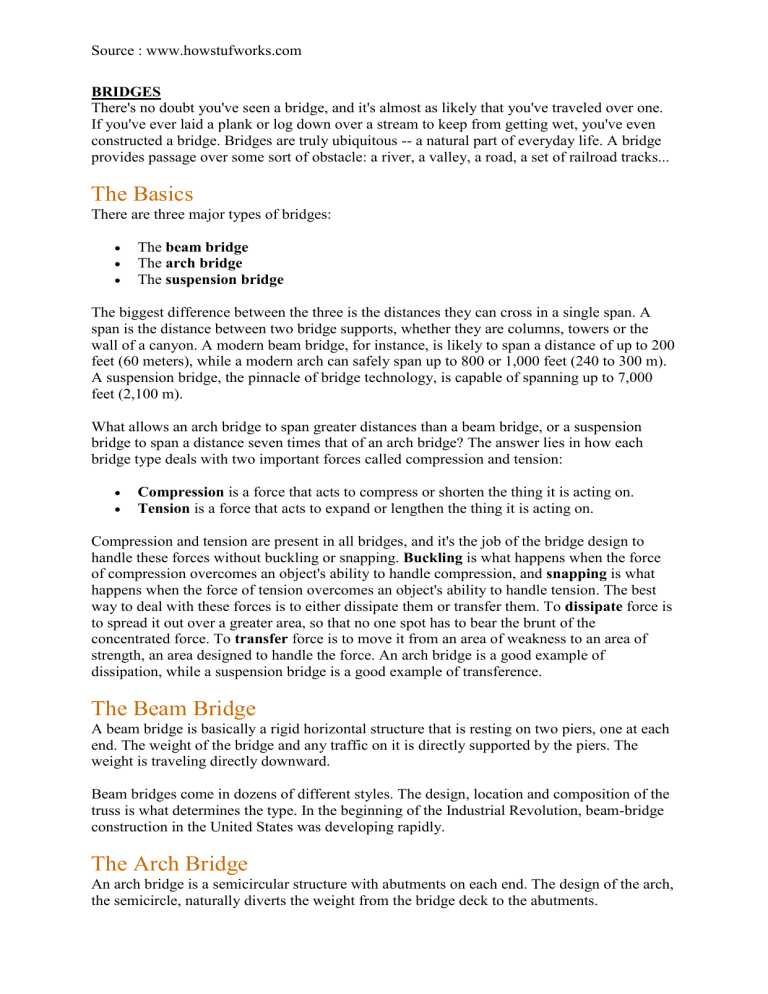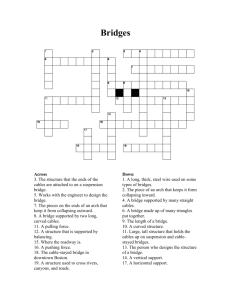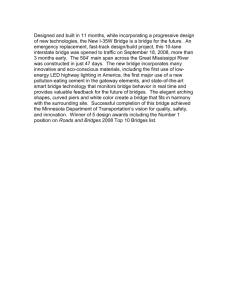Bridges

Source : www.howstufworks.com
BRIDGES
There's no doubt you've seen a bridge, and it's almost as likely that you've traveled over one.
If you've ever laid a plank or log down over a stream to keep from getting wet, you've even constructed a bridge. Bridges are truly ubiquitous -- a natural part of everyday life. A bridge provides passage over some sort of obstacle: a river, a valley, a road, a set of railroad tracks...
The Basics
There are three major types of bridges:
The beam bridge
The arch bridge
The suspension bridge
The biggest difference between the three is the distances they can cross in a single span. A span is the distance between two bridge supports, whether they are columns, towers or the wall of a canyon. A modern beam bridge, for instance, is likely to span a distance of up to 200 feet (60 meters), while a modern arch can safely span up to 800 or 1,000 feet (240 to 300 m).
A suspension bridge, the pinnacle of bridge technology, is capable of spanning up to 7,000 feet (2,100 m).
What allows an arch bridge to span greater distances than a beam bridge, or a suspension bridge to span a distance seven times that of an arch bridge? The answer lies in how each bridge type deals with two important forces called compression and tension:
Compression is a force that acts to compress or shorten the thing it is acting on.
Tension is a force that acts to expand or lengthen the thing it is acting on.
Compression and tension are present in all bridges, and it's the job of the bridge design to handle these forces without buckling or snapping. Buckling is what happens when the force of compression overcomes an object's ability to handle compression, and snapping is what happens when the force of tension overcomes an object's ability to handle tension. The best way to deal with these forces is to either dissipate them or transfer them. To dissipate force is to spread it out over a greater area, so that no one spot has to bear the brunt of the concentrated force. To transfer force is to move it from an area of weakness to an area of strength, an area designed to handle the force. An arch bridge is a good example of dissipation, while a suspension bridge is a good example of transference.
The Beam Bridge
A beam bridge is basically a rigid horizontal structure that is resting on two piers, one at each end. The weight of the bridge and any traffic on it is directly supported by the piers. The weight is traveling directly downward.
Beam bridges come in dozens of different styles. The design, location and composition of the truss is what determines the type. In the beginning of the Industrial Revolution, beam-bridge construction in the United States was developing rapidly.
The Arch Bridge
An arch bridge is a semicircular structure with abutments on each end. The design of the arch, the semicircle, naturally diverts the weight from the bridge deck to the abutments.
Source : www.howstufworks.com
There are, for example, Roman, Baroque and Renaissance arches, all of which are architecturally different but structurally the same. Arches are fascinating in that they are a truly natural form of bridge. It is the shape of the structure that gives it its strength. An arch bridge doesn't need additional supports or cables. In fact, an arch made of stone doesn't even need mortar. Ancient Romans built arch bridges (and aqueducts) that are still standing, and structurally sound, today. These bridges and aqueducts are real testaments to the natural effectiveness of an arch as a bridge structure.
The Suspension Bridge
A suspension bridge is one where cables (or ropes or chains) are strung across the river (or whatever the obstacle happens to be) and the deck is suspended from these cables. Modern suspension bridges have two tall towers through which the cables are strung. Thus, the towers are supporting the majority of the roadway's weight.
Suspension bridges come in two different designs: the suspension bridge, recognized by the elongated 'M' shape, and the less-common cable-stayed design, which has more of an 'A' shape. The cable-stayed bridge does not require two towers and four anchorages as does the suspension bridge. Instead, the cables are run from the roadway up to a single tower where they are secured.








